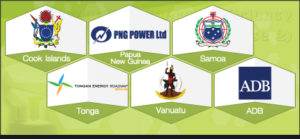
The objective of the PEEP2 project was to implement energy efficiency measures in the five Pacific Developing Member Countries (PDMCs) — the Cook Islands, Papua New Guinea (PNG), Samoa, Tonga, and Vanuatu, in order to contribute to achieving the overall goal reducing energy consumption in the residential, commercial and public sectors, and to establish the policy and implementation frameworks to move towards the goals of reducing fossil fuel imports, achieving total energy savings, and reducing greenhouse gas (GHG) emissions.
Savings Narrative:
A total of 35 EE projects were designed and 34 projects implemented following ADB procurement guidelines. The total investment (ADB component) was US$ 1,912,481 resulting in energy annual savings of 3,411 MWh, annual cost savings of $1,458,922 and CO2 savings of 3,204 tons/year. The average cost of saved energy across these projects, for example in Samoa was 6 US cents/kWh. This compare very favorably with the electricity tariffs in the PDMCs that range between 29 and 61 US cents/kWh, thereby demonstrating the economic attractiveness of EE measures.
The key achievements of PEEP2 include the following:
Development of an energy use database to provide access to information on electricity consumption and energy efficiency indicators at national and end-use sector levels. The database system was designed focusing primarily on the major end-use sectors (commercial and public sector buildings; residential sector, and street lighting); and is capable of accommodating expansion to include additional end-use sectors and countries in the future. The database was designed as a web-based system and is capable of operating in an “off-line” mode with all the core system components based on open source technologies.
The information on end-use consumption and energy efficiency indicators was used to support design, implementation and monitoring of various project activities under PEEP2.
Development of national EE targets for the five PDMCs based on a set of energy and economic parameters that influence projections of energy consumption and end-use energy savings. Projections were made for three policy scenarios – conservative, moderate and aggressive – for the years 2020, 2025 and 2030.
To improve EE best practices, several complementary activities were undertaken including: Energy Efficiency Technology Assessment, International Best Practices for Energy Efficiency Building Codes, Green Hotels Rating Scheme for the Pacific, Green Commercial Buildings Rating Scheme for the Pacific; and Energy Efficiency Assessment Guidelines, Framework and Scorecard.
Comprehensive energy audit training was conducted in all five PDMCs. The training program included four modules – Basic and Intermediate energy auditing (Modules 1 and 2) and Intermediate and Advanced energy auditing (Modules 3 and 4), practical on-site training and preparation of Investment Grade Audit Reports.